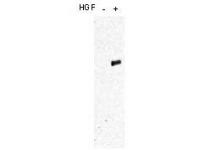MET Rabbit Polyclonal Antibody
USD 200.00
USD 867.00
USD 665.00
Specifications
| Product Data | |
| Applications | WB |
| Recommended Dilution | ELISA: 1:93,000, WB: 1ug/mL |
| Reactivities | Human, Mouse, Rat |
| Host | Rabbit |
| Isotype | IgG |
| Clonality | Polyclonal |
| Immunogen | This affinity purified antibody was prepared from whole rabbit serum produced by repeated immunizations with a synthetic peptide corresponding to residues surrounding Y1349 and Y1356 of human c-Met protein. |
| Formulation | 0.02 M Potassium Phosphate, 0.15 M Sodium Chloride, pH 7.2 |
| Conjugation | Unconjugated |
| Storage | Store at -20°C as received. |
| Stability | Stable for 12 months from date of receipt. |
| Gene Name | MET proto-oncogene, receptor tyrosine kinase |
| Database Link | |
| Synonyms | AUTS9; c-Met; DFNB97; HGFR; RCCP2 |
| Note | This antibody is designed, produced, and validated for Cancer, Immunology and Nuclear Signaling research. Anti-c-MET is the receptor for hepatocyte growth factor (also known as scatter factor, HGF/SF), and belongs to the tyrosine kinase superfamily. Interaction of c-Met with HGF results in autophosphorylation of c-Met at multiple tyrosines. Phosphorylation of Y1234/1235 in the c-Met kinase domain is critical to kinase activation. When phosphorylated, Y1349 and Y1356, along with surrounding amino acids, form a unique bidentate docking site for substrates such as Gab1, Grb2, phosphatidylinositol 3-kinase (PI3K) and others. C-Met mainly uses the Gab1 scaffolding adaptor in its initial step of signal transmission. Well-characterized downstream signalling pathways that are activated by c-Met include the ERK/MAPK, PI3K–Akt/PKB, Crk–Rap and Rac–Pak pathways, resulting in proliferation and increased cell survival. |
| Reference Data | |
| Protein Families | Druggable Genome, Protein Kinase, Transmembrane |
| Protein Pathways | Adherens junction, Axon guidance, Colorectal cancer, Cytokine-cytokine receptor interaction, Endocytosis, Epithelial cell signaling in Helicobacter pylori infection, Focal adhesion, Melanoma, Pathways in cancer, Renal cell carcinoma |
Documents
| Product Manuals |
| FAQs |
| SDS |
{0} Product Review(s)
Be the first one to submit a review






























































































































































































































































 Germany
Germany
 Japan
Japan
 United Kingdom
United Kingdom
 China
China




